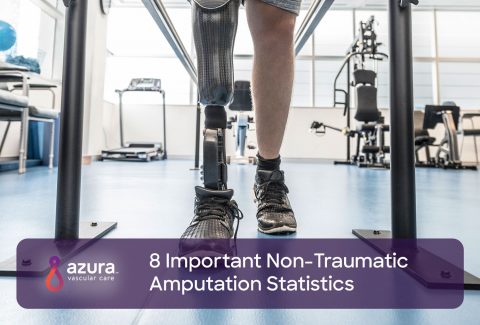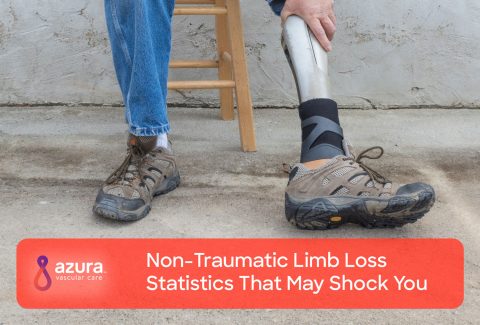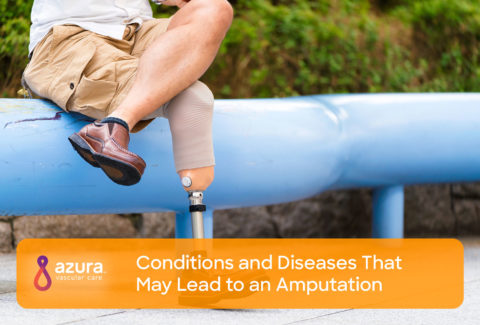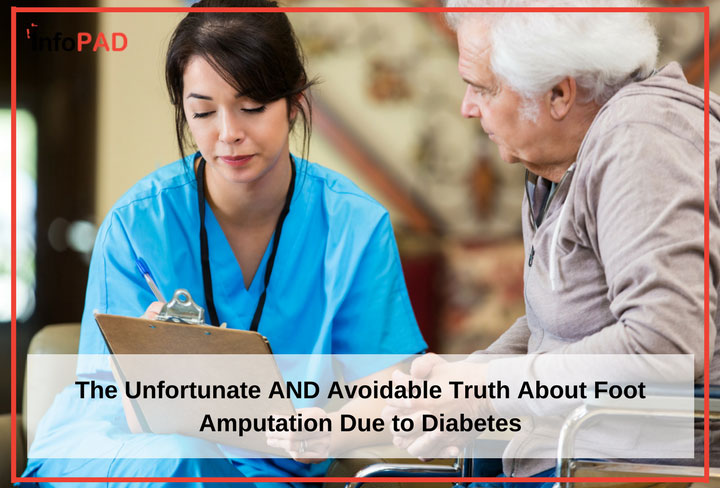
Every year, surgeons perform a lower-limb amputation due to diabetes on about 73,000 patients.[i] Most of these amputations are performed for the treatment of non-healing diabetic foot ulcers that resulted from peripheral arterial disease (PAD).[ii] These non-healing foot ulcers are caused by high blood glucose levels, which accelerate the direct damage to the nerves and blood vessels in the body, specifically the limbs. When left untreated, PAD can have serious complications, resulting in amputation, in its most severe form.
Leg or foot amputation due to diabetes can have significant physical and emotional consequences, not only for the person with the amputation, but to his or her loved ones as well. The most unfortunate part of this is, with proper medical care early on, some of these amputations could be avoided.
As mentioned earlier, peripheral artery disease (PAD) is commonly involved in non-healing ulcers. PAD is caused by obstructed blood flow in the arteries, resulting in oxygen and nutrients not being able to get to the ulcer to assist with healing. If you have a non-healing diabetic foot ulcer, it’s essential that you see your primary care provider as soon as possible.
What is Amputation?
Amputation is the surgical removal of a part of a limb. The types of lower-limb amputations that are commonly performed due to diabetes include:
- Partial foot amputation – Involves removal of a toe or more. Even removal of a toe will likely alter walking and balance.
- Below the knee amputation – Involves removing the lower leg, with or without removing the knee joint. Either way, the remaining part of the leg may still be able to bear weight and can move well with the use of a properly-fitted prosthesis, or a device designed to function as the part of the leg that was removed.
- Above the knee amputation – Involves removal of the leg above the knee joint where part of the femur, the bone in the thigh, is removed.
Non-Healing Diabetic Foot Ulcers Can Lead to Amputation
Lower limb amputation is performed for the treatment of non-healing diabetic foot ulcers in the following cases:
- Severe Soft-Tissue Infections – If an infection cannot be treated with
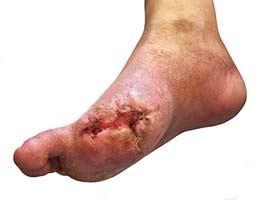 intravenous antibiotics and a patient’s life is at risk, then an amputation is often the only treatment option. An example of a severe infection is necrotizing fasciitis, which is a potentially life-threatening infection that involves the tissues of the skin and around the muscles and progresses rapidly.
intravenous antibiotics and a patient’s life is at risk, then an amputation is often the only treatment option. An example of a severe infection is necrotizing fasciitis, which is a potentially life-threatening infection that involves the tissues of the skin and around the muscles and progresses rapidly. - Osteomyelitis – This occurs when the infection has moved into the bone. The first treatment is weeks to months of antibiotic medications through a vein. Occasionally, this is not effective and the area that contains the infected bone needs to be removed.
- Critical Limb Ischemia – This happens when the blood supply is cut off suddenly, like in cases of a blood clot. It is painful and an emergency. If blood flow is not restored right away, the tissue could die and lead to gangrene.
- Gangrene – Gangrene occurs when the tissue dies and turns black. In some cases, the first course of treatment would be to attempt to surgically remove the dead tissue, however if this is not possible then the only other treatment is removal of the dead tissue through amputation.
RELATED: The One Thing You Should Do Right Away if You Have Non-Healing Diabetic Foot Ulcers
Role of Diabetes in Amputation
About 10% of people living with diabetes may have a foot ulcer.[iii] While many diabetic foot ulcers will heal with proper treatment, about 10-15% will not.[iv] Almost a quarter of those whose ulcers do not heal will ultimately require amputation.[iv] Amputation can often be avoided by seeking care as soon as possible after noticing a developing ulcer. Treatment should be conducted by a team that’s specialized in treating diabetic foot ulcers.[v,vi]
Role of PAD
PAD is a serious medical condition. The risk for diabetic foot ulcers increases seven times in people with peripheral diabetic neuropathy.[vii] There are treatments for PAD that can assist in the healing of foot ulcers. If you have PAD, you may experience:
- Pain in the legs with walking, which improves with rest
- Leg pain while at rest
- Fatigue in the legs with walking that improves with rest
- Pale or blue toes or feet
- A leg that is cooler than the other
- One or both legs without leg hair
- Toenails that grow slower than usual
If you have some of these symptoms, you may have PAD.
RELATED: 7 Things You Must Be Aware of If Your PAD Goes Untreated
Life After Amputation
Amputation of the foot or leg is life-changing. There are physical and emotional changes that occur after amputation as well, for both the patient and his or her loved ones. Some changes that can happen after an amputation include:
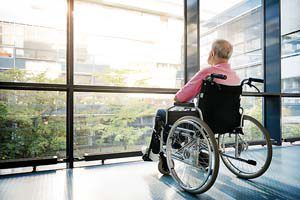 Loss of mobility – This can lead to feelings of grief and physical isolation.
Loss of mobility – This can lead to feelings of grief and physical isolation.- Conflict with family members and loved ones – Oftentimes, conflict arises because everyone in the household needs to change expectations about what the person with the amputation is able to do.
- Phantom limb pain (PLP) – This occurs when nerves trigger painful sensations that seem to be coming from the part of the limb that is no longer there.
- Stump care – The amputated stump will require specific care to avoid problems with healing that may include swelling and/or infection.
- Increased risk of death – Studies have shown that there is a 50% chance of death within 2 years of having an amputation.[viii]
While some of these issues can be overcome, of course the goal is to avoid amputation in the first place. For the best chance to avoid the need for amputation, please see your doctor right away if you have a non-healing diabetic foot ulcer. If you think you might have PAD, you should take the assessment and discuss the results with your doctor as soon as possible.
Sources:
[i] Centers for Disease Control and Prevention. National Diabetes Statistics Report: Estimates of Diabetes and Its Burden in the United States, 2014, Atlanta, GA: US Department of Health and Human Services; 2014. http://www.cdc.gov/diabetes/data/statistics/2014statisticsreport.html (accessed 8/1/2016)
[ii] American Diabetes Association. Consensus Development Conference on Diabetic Foot Wound Care: 7-8 April 1999, Boston, Massachusetts. American Diabetes Association. Diabetes Care 1999; 22: 1354-1360 [PMID: 10480782 DOI: 10.2337/diacare.22.8.1354]
[iii] Bartus CL, Margolis DJ. Reducing the incidence of foot ulceration and amputation in diabetes. Curr Diab Rep 2004; 4: 413-418 [PMID: 15539004 DOI: 10.1007/s11892-004-0049-x]
[iv] Pemayun, T.G.D., Naibaho, R.M., Novitasari, D., Amin, N., Minuljo, T.T., Risk factors for lower extremity amputation in patients with diabetic foot ulcers: a hospital-based case–control study. Diabetic Foot & Ankle, 2015. 6:10.3402/dfa.v6.29629. doi:10.3402/dfa.v6.29629. http://www.ncbi.nlm.nih.gov/pmc/articles/PMC4673055/ (accessed 8/5/2016)
[v] Margolis, D.J., Allen-Taylor, L., Hoffstad, O., Berlin, J.A., Diabetic Neuropathic Foot Ulcers. Diabetes Care, 2002, 25(10): p. 1835-1839. http://care.diabetesjournals.org/content/diacare/25/10/1835.full.pdf (accessed 8/4/2016)
[vi] Weck, M., Slesaczeck, T., Paetzold, H., Muench, D., Nanning, T., von Gagern, G., Brechow, A., Dietrich, U., Holfert, M., Bornstein, S., Barthel, A., Thomas, A., Koehler, C., and Hanefeld, M., Structured health care for subjects with diabetic foot ulcers results in a reduction of major amputation rates. Cardiovascular Diabetology, 2013, 12: article 45. http://cardiab.biomedcentral.com/articles/10.1186/1475-2840-12-45 (accessed 8/4/2016)
[vii] Reiber GE, Vileikyte L, Boyko EJ, del Aguila M, Smith DG, Lavery LA, Boulton AJ. Causal pathways for incident lower extremity ulcers in patients with diabetes from two settings. Diabetes Care 1999; 22: 157-162 [PMID: 10333919 DOI: 10.2337/diacare.22.1.157]
[viii] Brownrigg, J.R.W., Apelqvist, J., Bakker, K., Schaper, N.C., and Hinchliffe, R.J., Evidence-based management of PAD & the Diabetic Foot. Euro J Vasc and Endovasular Surg, 2013. 45(6): p. 673-681. http://www.ejves.com/article/S1078-5884(13)00136-6/abstract (accessed 7/30/2016)
